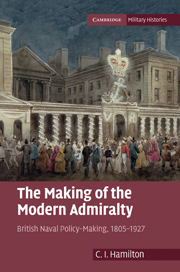Book contents
- Frontmatter
- Contents
- List of tables
- Preface
- Introduction
- 1 Lord Barham's Admiralty: 1805
- 2 Admiralty reform, 1806–1835
- 3 Decision-making at the Admiralty, c. 1806–1830
- 4 Admiralty administration and decision-making, c. 1830–1868. The Graham Admiralty
- 5 The Admiralty reformed again: context and problems, 1868–1885
- 6 Administrative and policy-making responses, c. 1882 onwards
- 7 Fisher and Churchill, and their successors, 1902–1917
- 8 The Naval Staff, planning and policy
- 9 Lord Beatty's Admiralty
- Conclusion
- Appendix 1 First Lords, First Sea Lords and Permanent Secretaries, 1805–1927
- Appendix 2 Acronyms and definitions
- Manuscript sources and select bibliography
- Index
3 - Decision-making at the Admiralty, c. 1806–1830
Published online by Cambridge University Press: 03 May 2011
- Frontmatter
- Contents
- List of tables
- Preface
- Introduction
- 1 Lord Barham's Admiralty: 1805
- 2 Admiralty reform, 1806–1835
- 3 Decision-making at the Admiralty, c. 1806–1830
- 4 Admiralty administration and decision-making, c. 1830–1868. The Graham Admiralty
- 5 The Admiralty reformed again: context and problems, 1868–1885
- 6 Administrative and policy-making responses, c. 1882 onwards
- 7 Fisher and Churchill, and their successors, 1902–1917
- 8 The Naval Staff, planning and policy
- 9 Lord Beatty's Admiralty
- Conclusion
- Appendix 1 First Lords, First Sea Lords and Permanent Secretaries, 1805–1927
- Appendix 2 Acronyms and definitions
- Manuscript sources and select bibliography
- Index
Summary
The Board of Admiralty
The First Lord was again a civilian once Barham resigned, and that remained the case for the rest of our period, with the brief exception of the Duke of Northumberland (1852–3). Nor were there any with previous experience of the naval offices, apart from three former Parliamentary Secretaries (Halifax, Corry and Northbrook), and two briefly tenured junior lords (Childers and Geddes). Thus, it might seem, most of our First Lords had to depend upon expert advice, and Admiralty decision-making took a collegiate form of some sort, centred on the Board of Admiralty. Unfortunately, testing that contention is not necessarily simple, since for the obscurity of the private closet we exchange the scarcely less puzzling enigma of the large executive committee.
One particular difficulty with sources has to be admitted: the lists of decisions made by the Board in the form of ‘Board minutes’ are no longer extant for our period, at least in coherent form, though from 1869 we have brief printed lists. We are not even sure how long meetings were, or that is the case from 24 June 1807, on which date the clerk wrote in the Board Journal ‘Begun to read at’, but did not – as previously – go on to show both start and finish times. Subsequently there does not seem to be any reference to such times at all.
- Type
- Chapter
- Information
- The Making of the Modern AdmiraltyBritish Naval Policy-Making, 1805–1927, pp. 80 - 115Publisher: Cambridge University PressPrint publication year: 2011

